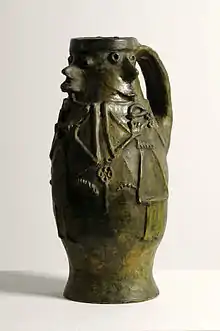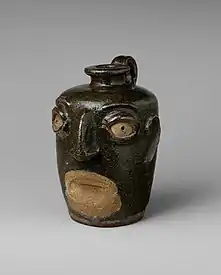Face jug
A face jug is a jug pottery that depicts a face. There are examples in the pottery of ancient Greece, and that of Pre-Columbian America. Early European examples date from the 13th century, and the German stoneware Bartmann jug was a popular later medieval and Renaissance form. Later, the British Toby Jug was a popular form, that became mass-produced. Especially in America, a number of modern craft potters make pieces, mostly continuing the 19th-century African-American slave folk art tradition.


The Jug in the Form of a Head, Self-Portrait (1899) by Paul Gauguin is a rare fine art example.
Early forms
England
During the 13th century, craftsmen outside of London became more decorative in their style, creating more anthropomorphic vessels that would characterize medieval face jugs.[2] In the 1600s full-body vessels supposedly modeled after Edward Vernon, also known as Admiral Vernon. These pieces came to be known as British Toby Jugs.[3]
Africa
African Nkisi figures, originating in Central Africa, were considered containers of both deceased souls and spiritual medicine. These figures were made with many different materials including clay. They came to the Americas via enslaved Africans, and are found more commonly in Latin American regions. The vessels are full figured pieces characterized by the same exaggerated human features often seen on African-American face jugs. Many rituals associated with Nkisi figures are used either to aid or to harm a person or other living creature that the figures play a stand-in role for, or as an extension of a spiritual leader, or as a being that stores spiritual energy.[4]
America

Some of the best-known vessels come from North Carolina, South Carolina and Georgia, made by African-American slaves in the mid-1800s. Though the jugs' exact purposes are unknown, many scholars believe they have either practical or spiritual value. Other names associated with African-American face jugs are grotesque jars, monkey jars, or face jars.[6] Modern interpretations started appearing in the same regions during the 1940s.[7] The making of face jugs among African Americans may have been influenced by Kongo creation of face jugs because face jugs made by Black Americans are somewhat similar in appearance to Kongo face jugs from Central Africa.[8][9] Archeologists interpreted the face jugs (face vessels) bulging white eyes to be a Bakongo practice of using white to symbolize the spirit world that are similar to nksisi nkondi in Central Africa.[10]
Face jugs were fully functional pieces that served the practical purpose of holding and pouring liquid. Various slave owner accounts hold that African-American slaves would use their face jugs to carry water into the fields with them.[11] Other scholars believe that face jugs were used as a form of self-identification, or a self-portrait and perhaps were a way for slaves to deal with their physical displacement and loss of visual worth.[12] Some folklore accounts held that these jugs were used for spiritual, rather than practical, purposes. It is believed that the jugs were buried outside of front and back doors to scare spirits away. It is also claimed that these jugs were used as grave markers and placed atop burial sites surrounded with the possessions of the deceased.[11]
As folk art, face jugs have become a significant feature in the history of African-American art. Because formal ceramic skills to create face jugs were taught after America gained its independence, they are regarded as some of the first truly American pieces.[13] Because of their interesting physical characteristics and historical context behind them, face jugs are important examples of African-American art and as the start of a theme of self-identification that would carry into the future.[14] Some use these vessels may have been as political symbols. Most famously, it is believed that Dave the Potter, a slave who worked in the Miles mill where face jugs were made, was himself protesting against his status through ceramic pieces.
List of American makers
American art potters who create face jugs include:
List of Latgalian makers
References
- Goulden, Barbara. THE HERBERT REVEALS ALL Coventry Telegraph 30 October 2008
- Spencer, Brian. "Medieval Face-Jug (The London Museum)." The Burlington Magazine 111, no. 794 (1 May 1969): 303–302.
- N., J. G. "Old English Pottery." The Burlington Magazine for Connoisseurs 58, no. 335 (1 February 1931): 98.
- Young, Jason R. Rituals of Resistance: African Atlantic Religion in Kongo and the Lowcountry South in the Era of Slavery. LSU Press, 2011.
- Loop, Maria. "Georgia Museum of Art to show 19th-century African-American face jugs". University of Georgia Today. University of Georgia. Retrieved 4 March 2022.
- "Encyclopedia Smithsonian: American Face Vessels." Accessed 13 September 2014. http://www.si.edu/Encyclopedia_SI/nmah/facevess.htm.
- Ketchum, William C. (2003). "JUGS, FACE". The Encyclopedia of American Folk Art. Cynthia Parzych Publishing, Inc.
- University Staff. "Kongo, Louisiana, and the Black South" (PDF). Duke University / The Black Atlantic. Duke University. Retrieved 4 March 2022.
- Vlach (1990). The Afro-American Tradition in Decorative Arts. The University of Georgia Press. pp. 82–86.
- Fennell (2013). "Kongo and the Archaeology of Early African America" (PDF). Kongo Across the Waters: 234. Retrieved 26 May 2022.
- Watch Now: History Detectives | Face Jug. Accessed 10 September 2014. http://video.pbs.org//video/1918318256
- Hall, James. The Self-Portrait: A Cultural History. Thames & Hudson, 2014.
- Patton, Sharon F. African-American Art. Oxford University Press, Incorporated, 1998.
- Dover, Cedric. American Negro Art. New York Graphic Society, 1967.
- "Jugheads are the artist's best friend". claytonbailey.com.
External links
- Selections of nineteenth-century Afro-American Art, an exhibition catalog from The Metropolitan Museum of Art (fully available online as PDF), which contains material on face jugs